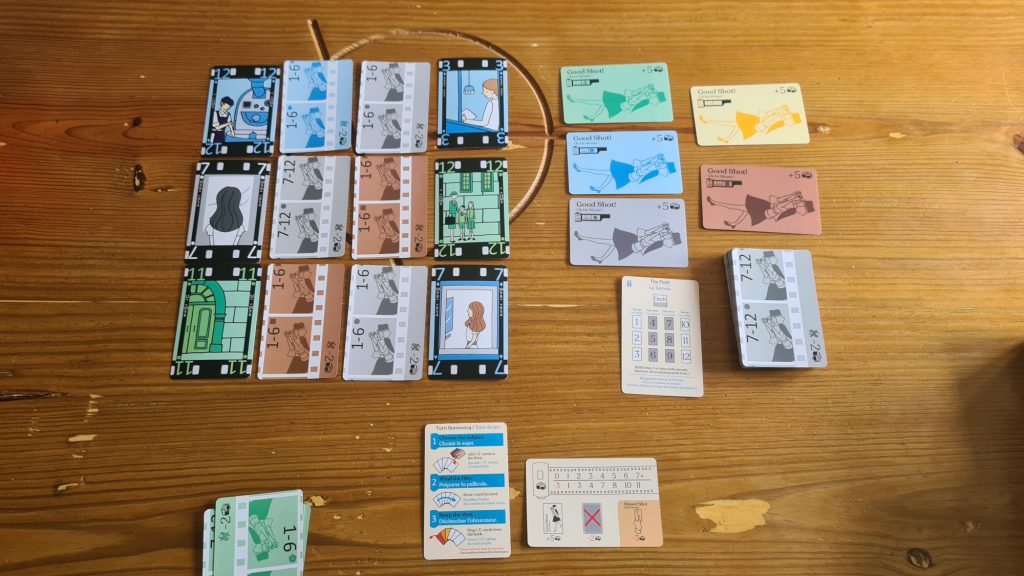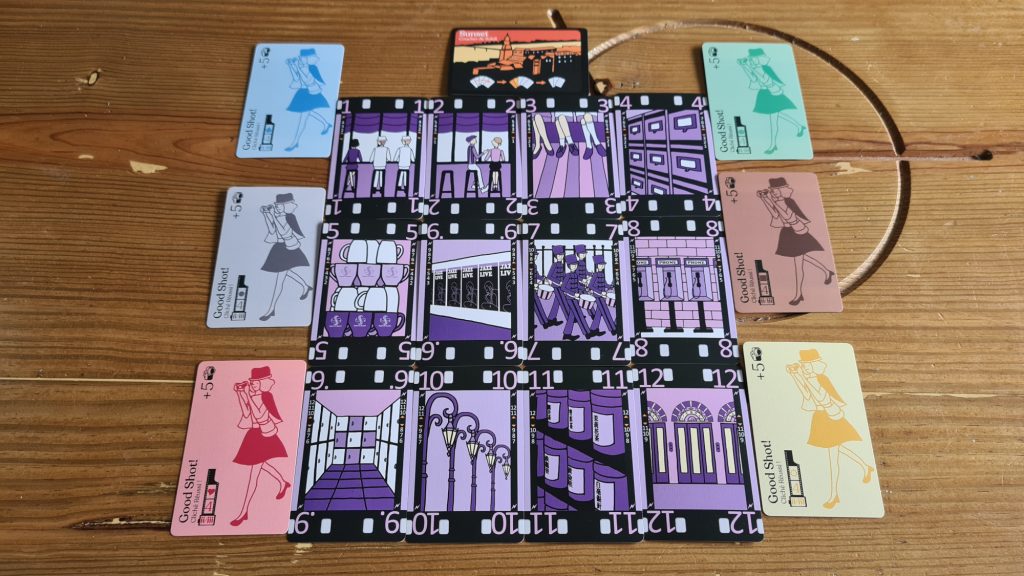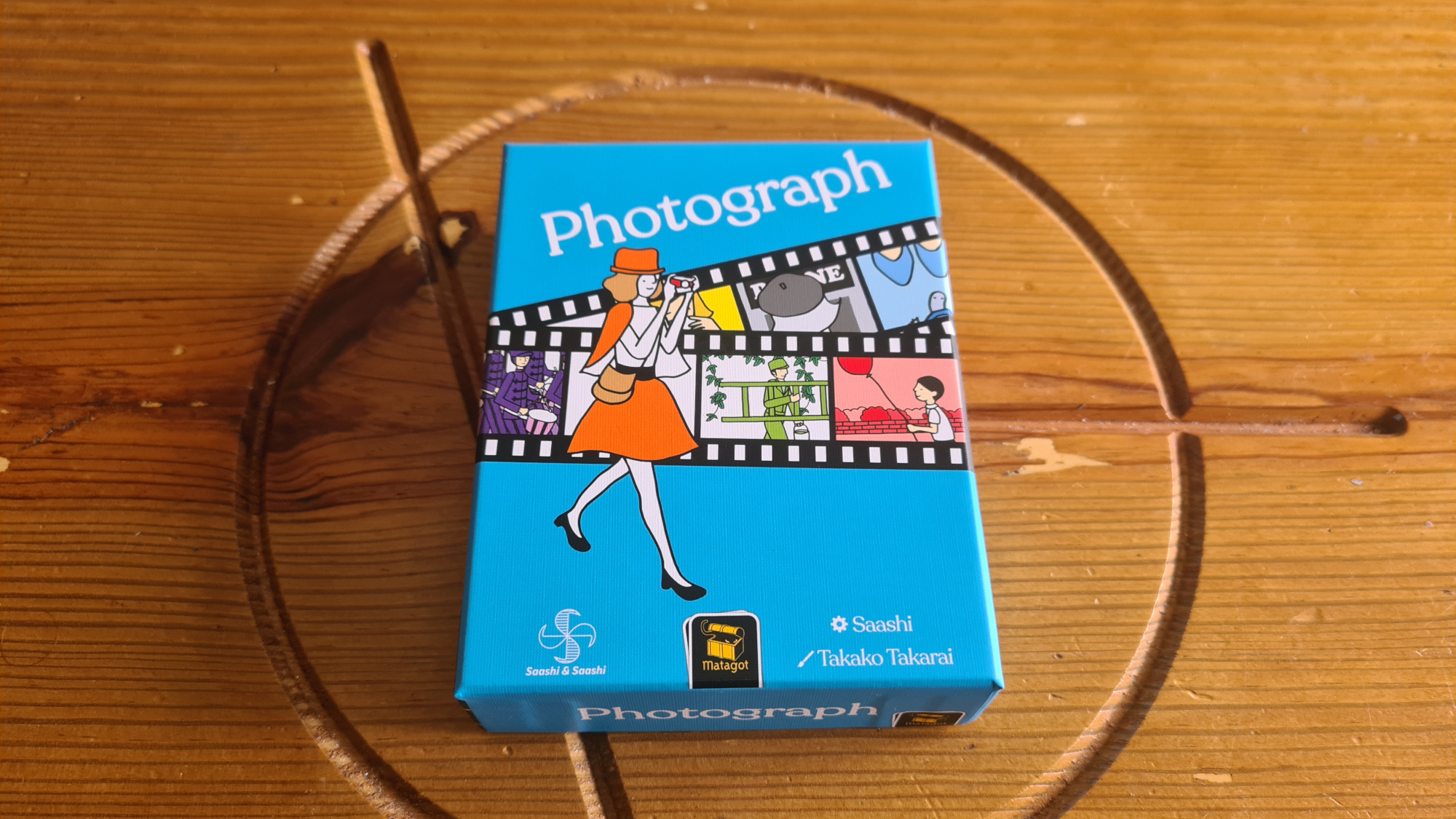Photograph, also known by the name Wind the Film, is a card drafting, hand management and set collection card game from Matagot. Designed by Saashi & Saashi, the game sees 2 – 4 players spend around 20 minutes taking photographs; attempting to keep them in focus and not missing any shots. However, is Photograph a landscape to behold or one that wouldn’t even be shared on social media? Let’s find out!
Players start by sorting out the deck, with 5 colours used for 2 players and an additional colour added in per additional player. The deck is then shuffled before being split into 6 approximate piles. A special sunset card is shuffled into one of these piles. Four normal piles of cards are stacked on top of the sunset pile, with the final pile placed underneath. Finally, the good shot bonus cards for the included colours are placed within reach. The first round is then ready to be set up.
Depending on the player count, each round a 3 x 4 (2 players) or a 4 x 4 grid (3 – 4 players) is made in the middle of the table. The outside two columns of cards are dealt out face up, with the central 2 columns face down. One twist with the cards in Photograph are the card backs. Not only do the card backs reveal what colour the card is, they also indicate if the card is high or low.
Starting with whoever last took a photo, each player draws 5 cards from the deck into their hand. This is done a card at a time, with the order of the cards importantly staying in the drawn order. On a player’s turn they follow 4 steps. The player must first add cards from the central display to their hand. They choose a number of cards to pick up, between 1 – 3, and then from the left or the right of any row they claim that many cards. The claimed cards like the starting cards must be added to the front of their hand in order.

Next, the player must wind the film, moving any card in their hand forward – towards the newly added cards. The shot can then be taken. Playing as many cards as drawn at the start of the turn the player plays cards from the back of their hand. The first card in any colour is always legal to play. From this point the player can legally play a card of that colour that is either up to 3 higher or lower in value. If a card is within 3 then this sets that “suit” to be an ascending or descending – with future cards needing to also follow this as a requirement.
If a card isn’t within 3, or it doesn’t follow the ascending/descending order, then it is still played, but it is an out of focus shot – placed face down. One positive is that this removes the within 3 value requirement for cards of the colour moving forward. The first player to correctly play enough cards of a colour (4 cards for 2 – 3 players and 3 for 4 players) gains a bonus good shot card for that colour. The final stage of a player’s turn is to check the field. When it gets down to 3 or fewer cards the field is refilled.
Towards the end of the game, when refilling the field, the Sunset card will be drawn from the deck. This triggers a special event. Each player must wind the film, moving a card forward in their hand, and then play the back two cards from their hand. This leaves players with only 3 cards in their hand during what is the final round. When the field of cards again gets down to 3 or fewer cards the game end occurs.
Another sunset-like event occurs, with players winding the film and playing a final two cards – discarding their remaining one. Players then calculate the points earnt. The more cards not out of focus played in each colour the more points a player receives, with not having any of a colour costing 3 points. 2 points are then lost for each out of focus card and 5 bonus points are earnt for acquired good shot cards. The winner is whoever has the most points, with ties split by the amount of good shot cards a player gained.
There is one rule that sticks out as somewhat unnecessary. During the sunset and end of the game final event, players cannot gain the Good Shot awards. This can result in a player having in front of them a run of up to 5 cards of a colour correctly played and get nothing for it, just because it’s in these phases. Another player can then come along and claim the Good Shot bonus card and points for only 4 cards on the next turn. This can leave players with a bit of a feeling of being screwed over by the game, and it’s an exclusion to the normal rules – so one extra thing to remember.

Intuitively, players get the need to play cards in ascending or descending order. However, there is something grained into gamers when looking at a hand of cards to reorder them into a useful order. Players must break this habit, and this almost throws players off for the first few round of the game. Not having the ability to freely move cards in your hand results in the chance to wind one card each turn becoming super important. Not only does it drive how risky players can be, with drawing face down cards, it will at times force a player to only pick up a single card to squeeze another wind in.
Winding can also be problematic, as it is mandatory. Certainly when sunset occurs and again at the very end, players are forced to wind. Knowing when these might happen or triggering them at the right time can slightly screw over an opponent. For much of the game players will happily have runs of cards in their hand. When forced to wind towards the end, players will need the cards to be out of order pre-wind, else they’ll only be taking out of focus shots.
Photograph looks almost whimsical with colourful cards that feature pleasant cartoon storyboards. These make the game look like it should be a light, playful experience, but within a few turns the true nature of Photograph becomes apparent. It’s a rather brain burny little card game, with every turn an important decision to be made. From the way the number of cards drawn dictates the number that must be played, to attempting to work out the chances of what face down cards are choices can easily come back to haunt you. Throw in the amount of points a player can lose from out of focus shots and getting the perfect order of cards in their hand becomes a challenge players must attempt.
In a two player game it can at times feel a little out of reach for one player. With all of the cards played onto the table, a player with significantly more out of focus cards can see that they are behind. When this happens it is hard to fight back from and means that unless the cards come out in a specific way players know the outcome of the game before the end is reached. Of course, not every game is like this – with some insanely tight games. As soon as another player is added into the mix though, it becomes a lot harder to predict who is doing the best – potentially due to the extra colours being added into the deck.
There is that something special in Photograph that makes it feel unique. No other card game is quite the same, with the hand management – the card order – being such an important part. For a card game the theme of winding on the film each time, whether you like it or not, shines through, and provides an incredible aspect of the puzzle. The colourful visual presentation masks the thinky experience. The amount of thought that can go into every turn may put analysis paralysis suffers off. Photograph isn’t just different for the sake of it, the small unique aspects make it stand out and earn its space on my gaming shelf!
(Editor’s Note: Photograph was provided to us by Asmodee for the review. The game is currently available from local board game stores! Find your local store here.)

